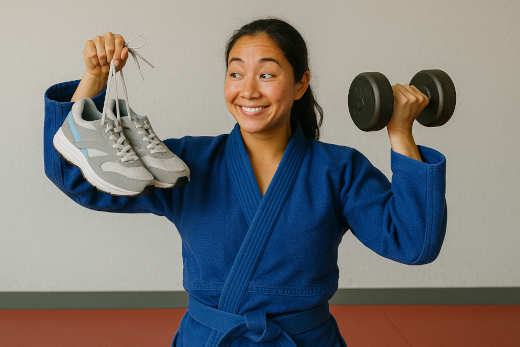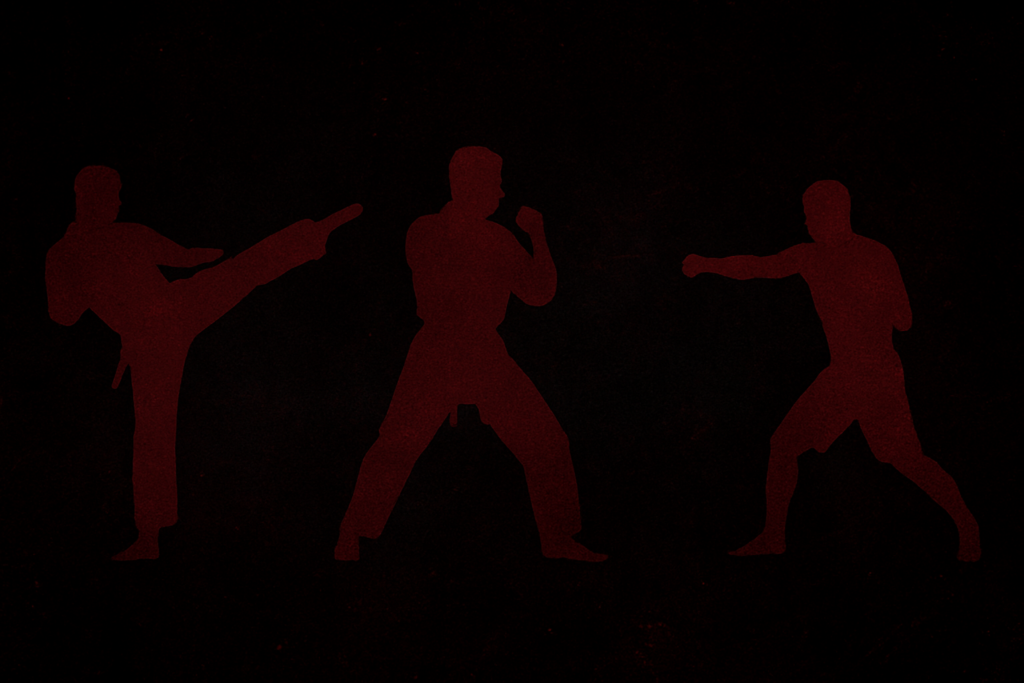Boost Power, Flexibility & Mindset
Introduction

Even the most dedicated martial artist benefits from cross-training — exploring other physical disciplines to improve performance, balance weaknesses, and prevent burnout. Smart cross-training doesn’t replace your main art — it enhances it.
In this post, we’ll cover five powerful cross-training methods that build endurance, strength, coordination, and mental sharpness for martial artists of any style.
🏃♂️ 1. Running and Sprint Intervals — The Endurance Base
Running remains one of the most effective tools for improving fight stamina.
- Long runs (30–45 min) build your aerobic base, which supports recovery and sustained effort.
- Sprint intervals (20–30 sec bursts with rest) improve anaerobic capacity and simulate bursts in sparring/fights.
These modalities help prepare your body for both sustained effort and explosive moments inside your art.
🏋️ 2. Functional Strength Training — Building Explosive Power
Martial arts strength isn’t about size — it’s about functional control, power, and stability.
Functional training studies (vs. traditional) show improvements in muscular fitness and endurance in combat sport practitioners. PMC: Comparing the effects of traditional resistance training and functional training on the bio-motor capacities of female elite taekwondo athletes
A recent review found that functional training and conventional training both significantly improve muscular endurance in Taekwondo athletes. BioMed Central: Effects of functional training on physical and technical performance amonh the athletic population: a systematic review and narrative synthesis
Focus on compound, athletic lifts that engage multiple muscle groups.
Recommended movements:
- Deadlifts and squats for lower-body drive
- Pull-ups and rows for grip and pulling strength
- Push presses and kettlebell swings for hip explosion
These compound movements increase power and improve efficiency in your martial (striking, grappling) movement.
🧘 3. Yoga and Mobility Work — Flexibility & Recovery
Yoga is one of the most underrated tools for martial artists. It:
- Enhances joint mobility and flexibility
- Improves breathing control and focus
- Aids recovery and injury prevention
Even 15–20 minutes of yoga or dynamic stretching after training can reduce soreness and improve kicking range.
🥊 4. Combat Conditioning — Mix Martial Arts with Functional Tools
Using unconventional training tools helps build durability and movement quality while it also keeps training exciting and effective:
- Battle ropes: Build upper-body endurance and grip strength.
- Sledgehammer or tire work: Develop rotational power.
- Sandbags or Bulgarian bags: Improve core and stabilizer engagement.
These tools simulate fight fatigue demands and teach your body to stay sharp under load.
🚴 5. Cross-Training & Novel Movement Training — Sharpening Coordination
Trying another sport helps your nervous system adapt faster and gives you a mental reset:
- Swimming: Builds full-body endurance with low impact.
- Climbing: Improves grip, core tension, focus, and body awareness.
- Dance or Capoeira: Develops rhythm, timing, and agility.
- Team sports: Build coordination and reaction under dynamic conditions.
Physical activity is increasingly recognized as a modulator of neuroplasticity — exercise helps the brain adapt, form new neural connections, and improve cognitive function.
Sources: Frontiers: Exploring the landscape of physical activity and neuroplasticity research: a comprehensive bibliometric review, PMC: Effects of Physical Excercise on Neuroplasticity and Brain Function: A Systematic Review in Human and Animal Studies
Many elite fighters supplement training with sports that build balance and adaptability — critical traits in high-level combat.
🧠 6. The Mental Edge of Cross-Training
Training in new environments challenges your brain — and that keeps motivation high.
You learn to stay humble as a beginner again, which sharpens focus and open-mindedness.
According to a review in Frontiers in Psychology (2021), varied physical practice enhances neuroplasticity and cognitive resilience — benefits that directly translate to improved fight IQ.
⚖️ 7. Sample Weekly Cross-Training Schedule
| Day | Focus | Activity | Duration |
|---|---|---|---|
| Mon | Martial Arts + Mobility | Kickboxing + Yoga | 75 min |
| Tue | Conditioning | Sprints + Strength Circuit | 60 min |
| Wed | Active Recovery | Light swim or walk | 30–40 min |
| Thu | Martial Arts Drills | Technique + Pad Work | 60 min |
| Fri | Functional Training | Kettlebell or resistance bands | 45 min |
| Sat | Cross-Sport | Climbing or light team sport | 60 min |
| Sun | Rest | Meditation or gentle stretching | — |
Conclusion
Cross-training keeps martial artists balanced, resilient, and motivated.
It strengthens your weaknesses, prevents overuse injuries, and develops new movement patterns that enhance your main art.
Blend conditioning, strength, flexibility, and mental training — and your martial arts progress will accelerate faster than ever.
Train smarter, not just harder — your art will thank you.

